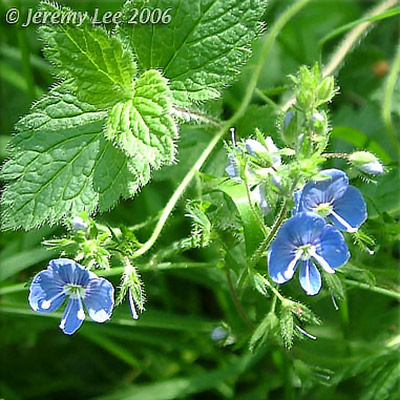
 |
|
Scientific Classifications explained » Amphibians » Ants » Aphids » Bees » Beetles » Birds » Bugs » Butterflies » Caterpillars » Damselflies » Dragonflies » Earwigs » Flies » Frog/Leafhoppers » Fungi » Galls » Grasshoppers » Harvestmen » Hoverflies » Lacewings » Ladybirds » Leaf Mines » Lichens » Mammals » Millipedes » Mosses » Moths » Sawflies » Slugs » Snails » Spiders » Trees & Shrubs » Wasps » Wild Flowers » Woodlice » Postboxes |
UK Nature > Wild Flowers > Blue & Purple Wild Flowers > Veronica chamaedrys

Scientific Name: Veronica chamaedrys Common Name: Germander Speedwell Veronica chamaedrys, more commonly known as Germander Speedwell, is found in grassland, woods and also in scree slopes. Growing to a height of c.25-50cm, with flowers c.9-12mm in diameter. The flowers are in spikes arising from leaf axils. Leaves hairy, unstalked or with a stalk up to 5mm in length. The flower-stalks are at least as long as the bract at their base, and at least as long as the calyx. The two lines of hairs up the stem are nearly always present and are enough on their own to identify the plant, but in deep shade the stem is sometimes equally hairy all round. The leaves are well-toothed and the fruit-capsules are shorter than the calyx. The flowers are normally bright blue with a white eye, but occasionally appear to be more of a mauve colour. |
|

https://www.uknature.co.uk is a website dedicated to showing the immense diversity of UK nature and wildlife. Our vast range of habitats, from lowland arable to snow covered mountains, from storm-ravaged coastlines to peaceful inland freshwater lakes and rivers, from dry, sandy heaths to deciduous and coniferous forests, all these habitats contribute to the abundance of UK nature. We have wild birds in huge numbers either residing or visiting our shores (597 recorded species as at July 2013) and we must also not forget the humble back garden with its grass lawns, flower beds filled with nectar rich flowers, shrubs and trees, all designed to attract huge numbers of insects such as bees, moths, butterflies and hoverflies; and finally the small ponds which provide safe havens for frogs, toads, newts and even slow worms and grass snakes. www.uknature.co.uk is the showcase for my personal passion, photographing uknature in all its glory. I sincerely hope you all enjoy the fruits of my labours. This site and all images contained therein is © Jeremy Lee 2004 - 2025. All Rights Reserved. Site design by Jeremy Lee. Site development & IT Support by Stuart Lee. |